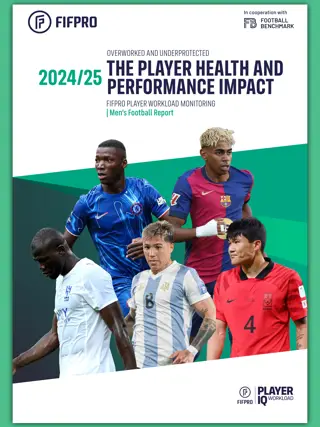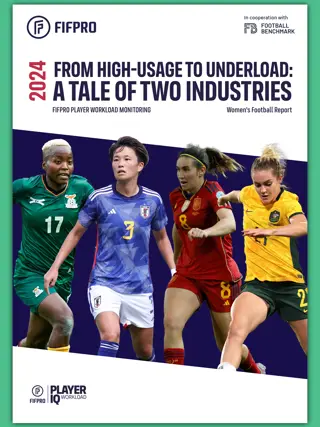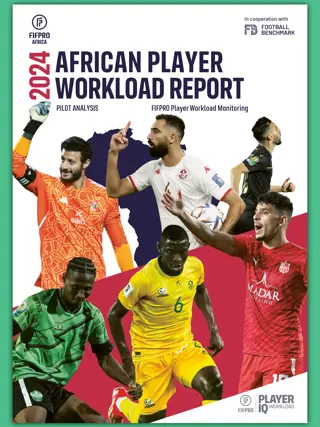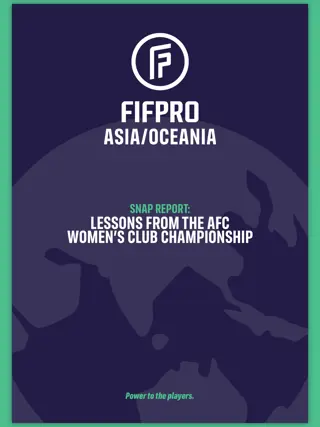News
New study: Women’s calendar growth is fragmented, piling too many games on some players but providing too few for others

- FIFPRO study with Football Benchmark shows some players are playing a lot of games, but most have too little football
- New competitions tend to be in Europe and North America, with none scheduled in South America, Africa or Oceania
- The study shows some players had 64 games last season, others had less than 10, underling the need for more balance
The growth of women’s football competitions is bringing increased recognition and professionalisation in parts of the world, but piling excessive pressure on some players, and failing to address wider issues like uneven games and underload, according to a FIFPRO study.
The study, From High-Usage to Underload: A Tale of Two Industries, compiled with Football Benchmark, shows disproportionate development, with new or expanded competitions in a few countries, notably in Europe and North America, and little or no development elsewhere. This uneven growth creates an imbalance in the number of games for professional women footballers, with some over-stretched by too many matches, but the majority having too few.
Mariona Caldentey played in 64 games last season for Barcelona and Spain, more than anyone else in a FIFPRO study of 300 players featured in the report, but the average amount of games per player was 33, which evens out at less than one match per week.

The gulf in competitive match opportunities was demonstrated at the 2024 Paris Olympics. Moeka Minami, the Roma defender had played more than 4,500 minutes of competitive football in the previous 12 months, while some of her Japan team-mates had played barely 1,000 minutes.
In another statistic showing the gulf in playing time, Spain’s squad had 17 players who participated in at least 30 games before the Olympics, while Colombia had only five.
New or expanded competitions scheduled for 2025 include a second-tier UEFA club competition, and the FIFA Women’s Club World Cup. Leagues in Germany, Italy, Japan, Sweden and the U.S. have expanded, or plan to expand. Meanwhile, the Women’s Super League (WSL) in England has not expanded since 2018. Growth in some regions remains stagnant and lacking investment: there are no new regional competitions planned in South America, Africa or Oceania.
"There is a two-speed development of women’s football," Dr. Alex Culvin, FIFPRO’s Director of Policy and Strategic Relations for Women’s Football, said. "There are players who are squeezed by the calendar and the high cadence of games; this is an issue that is rightly gaining more attention. Yet there are a larger proportion of players who do not have enough competitive matches and are often overlooked.
"Putting players at the centre of any, and all, dialogue on the calendar and the regularity of games is key to finding solutions. It is important that all stakeholders recognise the depth and diversity of the issues and work together to create a more balanced calendar that, whilst continuing to accelerate growth, also creates more competitive opportunities and provides guaranteed rest periods."
FIFPRO is advocating for the following measures to protect player health and performance, and accelerate professionalism more evenly:
- Mandatory off-season breaks of four weeks, and in-season breaks of two weeks, to protect players from overload
- Minimum conditions for travel, preparation and recovery
- New competitions or the expansion of leagues and other competitions to provide more games for underloaded players
Even in Europe, national and continental competitions are often lopsided. The study shows that the UEFA Women’s Champions League was one of the most imbalanced over the last decade, with an average goal difference of 2.38 thanks to a few teams including Olympique Lyonnais and Barcelona dominating smaller ones.
Of 10 women’s football competitions analysed in the report, the most balanced league was the National Women’s Soccer League (NWSL), which operates a franchise system with a progressive Collective Bargaining Agreement that includes a revenue sharing model and uniform team spending. The NWSL’s average goal difference in the 2024 season was 1.32; over the last decade, the NWSL had the lowest number of ‘blowout’ games, defined as matches in which there was a margin of four goals or more.
The NWSL had an average of 0.4 'blowout' games every 10 games over the last decade, compared to 2.17 for the German league and 2.31 for the French league, which have been dominated by a small group of teams over that period: Bayern Munich and Wolfsburg in Germany, Paris Saint-Germain and Olympique Lyonnais in France.
There are major disparities in how top clubs approach squad rotation, the report says. Sometimes it is by choice: there are a few top clubs, such as Barcelona, that can afford to rest key players in certain periods of the season. However, other teams use an almost-identical line-up every week, relying on the same core group of players. Roma had four players on the pitch for more than 80 percent of its 41 games last season, including Minami who averaged 96 minutes per game.









